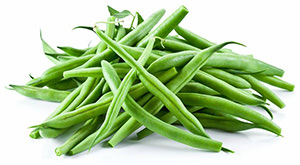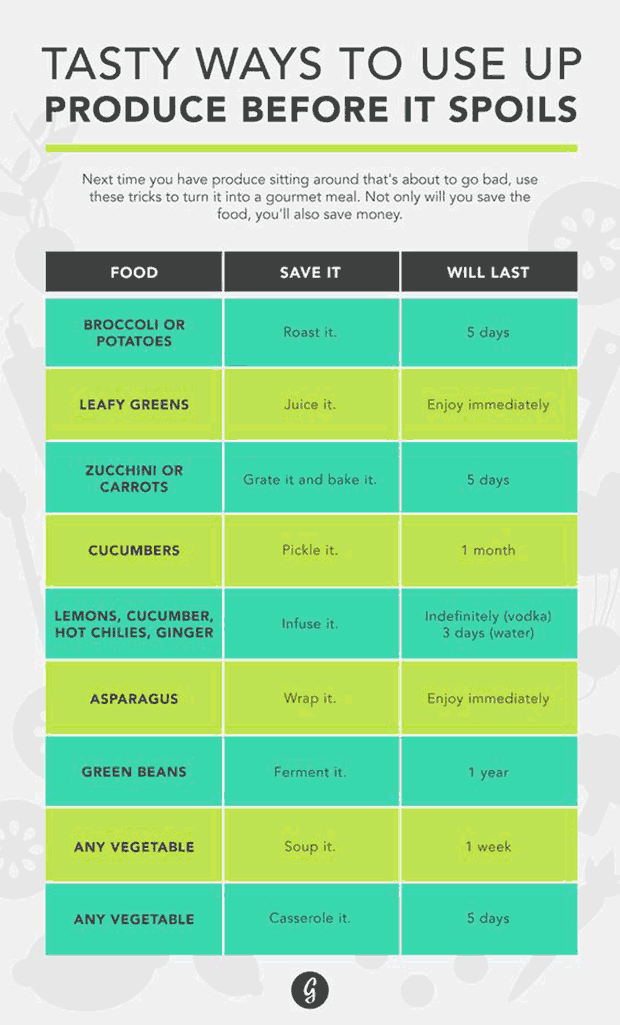
How to Bring Any Almost-Spoiled Produce Back to Life

Posted on 09 Jan, 2021

As hard as we all try to only buy as much produce as we'll eat for a few days, something always ends up sitting around until it's moldy, slimy, or shriveled beyond recognition, leaving us no choice but to toss it (and our money) in the trash.
The solution isn't to stop buying kale or zucchini. Instead, use these saves to turn almost-spoiled produce into a gourmet meal. Not only will you save the food, you'll also save money—and discover some delightful dishes along the way.
 Broccoli or Potatoes
Broccoli or Potatoes
Save it: Roast it.
There isn’t a vegetable inside the crisper that doesn’t love being roasted, but this is a terrific way to use up broccoli or potatoes in particular. The high, dry heat draws sugars to the surface, which causes the crisp edges and sweet flavor that makes roasted veggies a fave. Preheat the oven to 450 degrees, toss evenly cut veggies with olive oil to coat, and roast until golden brown and tender, usually 5 to 20 minutes. Cooked this way, they will stay good another five days in the fridge and can be used in soups, salads, omelets, and pasta, or eaten as is.
 Leafy Greens
Leafy Greens
Save it: Juice it.
You probably don’t have a juice bar-caliber juicer on hand, but you don't need one to make juice. Your blender can do the same work with your cache of kale or Swiss chard. Just blend with an apple and water, and strain out the pulp afterward for a revitalizing juice-bar type beverage that costs you $0, not $14. You can also leave the pulp in for a “blend” if you prefer that kind of thing.
Cucumbers
Save it: Pickle it.
 Slice or dice lingering onions or cucumbers, sprinkle liberally with salt and sugar, and let stand until the sugar and salt has dissolved and drawn some liquid out of the veggie. Then douse it with a 50-50 mix of water and vinegar (a milder vinegar, like rice vinegar, is best) and stash in the fridge. Check out this quick pickle recipe for more detailed instructions.
Slice or dice lingering onions or cucumbers, sprinkle liberally with salt and sugar, and let stand until the sugar and salt has dissolved and drawn some liquid out of the veggie. Then douse it with a 50-50 mix of water and vinegar (a milder vinegar, like rice vinegar, is best) and stash in the fridge. Check out this quick pickle recipe for more detailed instructions.
Lemons, Cucumber, Hot Chilies, Ginger
Save it: Infuse it.
 A pile of produce can be the start of DIY flavored vodka. Take lemon peels, cucumber, hot chilies, or ginger and steep them for two weeks in plain vodka. Voilà! You have homemade spirits to make cocktails the next time friends come over. More into water than booze? You can infuse H2O the same way, only faster: The water will pick up some flavor in just a couple hours. (Fruit is great for infused water too.)
A pile of produce can be the start of DIY flavored vodka. Take lemon peels, cucumber, hot chilies, or ginger and steep them for two weeks in plain vodka. Voilà! You have homemade spirits to make cocktails the next time friends come over. More into water than booze? You can infuse H2O the same way, only faster: The water will pick up some flavor in just a couple hours. (Fruit is great for infused water too.)
Zucchini or Carrots
Save it: Grate it.
 Use a box grater to turn produce—especially zucchini or carrots—into easy-to-use confetti. Scatter it raw in your salad, sauté it in your stir-fry, fold it into bread batter, or mix with an egg and a bit of flour to make a batter you can fry up into tasty fritters. (You will probably eat them all up, but if you don't, extras freeze very well.)
Use a box grater to turn produce—especially zucchini or carrots—into easy-to-use confetti. Scatter it raw in your salad, sauté it in your stir-fry, fold it into bread batter, or mix with an egg and a bit of flour to make a batter you can fry up into tasty fritters. (You will probably eat them all up, but if you don't, extras freeze very well.)
 Asparagus
Asparagus
Save it: Wrap it.
When it comes to eating your vegetables, tortillas can be you BFF. Sauté chopped asparagus with a little garlic, cumin, and hot sauce to make a flavorful vegetarian taco filling. If you want some protein, when the asparagus gets tender, toss a beaten egg into the pan and scramble. Fold into a corn tortilla and top with salsa, and you’re good to go.
 Green Beans
Green Beans
Save it: Ferment it.
At-home fermentation sounds much scarier than it is. Chop your excess green beans into even one-inch pieces and stuff them in a wide-mouth pint jar, leaving about 2 inches at the top. Cover with a brine (add 1 1/2 teaspoons sea salt to 2 cups filtered water), and use a smaller jar to weigh down the beans so they stay submerged. Throw a clean kitchen towel over the top and leave at room temperature for three to seven days. You’ll have a fermented pickle that will last one year in the fridge and a free dose of probiotics every time you snack on them.
Any Vegetable
Save it: Soup it.
Make cream-of-whatever soup: Cook a chopped onion in butter or olive oil, add a few cups of chopped veggies (broccoli, parsnips, winter squash, pretty much you name it) and cover with stock or water. Simmer until the vegetables are nice and tender, then purée in a blender. Season the soup well with salt and pepper. The cooked vegetables will make it creamy, but you can always add a touch of cream for extra richness. Use up any lingering parsley at the same time by mincing it and adding to the soup just before serving.
[Related: 38 Things You Can Freeze To Save Time And Money]
 Save it: Casserole it.
Save it: Casserole it.
How do you take baked mac and cheese from mediocre to five-star? Add some veggies. (Butternut squash and cauliflower are especially nice.) You can also make a more free-form casserole by combining two cups of any cooked grains with chopped vegetables, cheese, and a beaten egg.

Best Kitchen Hacks

by Justin Chapple

by Katie Mankoff


by Priya Krishna
 A List Of Foods You Should Not Freeze
A List Of Foods You Should Not Freeze 38 Things You Can Freeze To Save Time And Money
38 Things You Can Freeze To Save Time And Money Food Labelling Traps To Avoid
Food Labelling Traps To Avoid All You Need To Know About Buying, Storing And Using Coconut Oil
All You Need To Know About Buying, Storing And Using Coconut Oil










